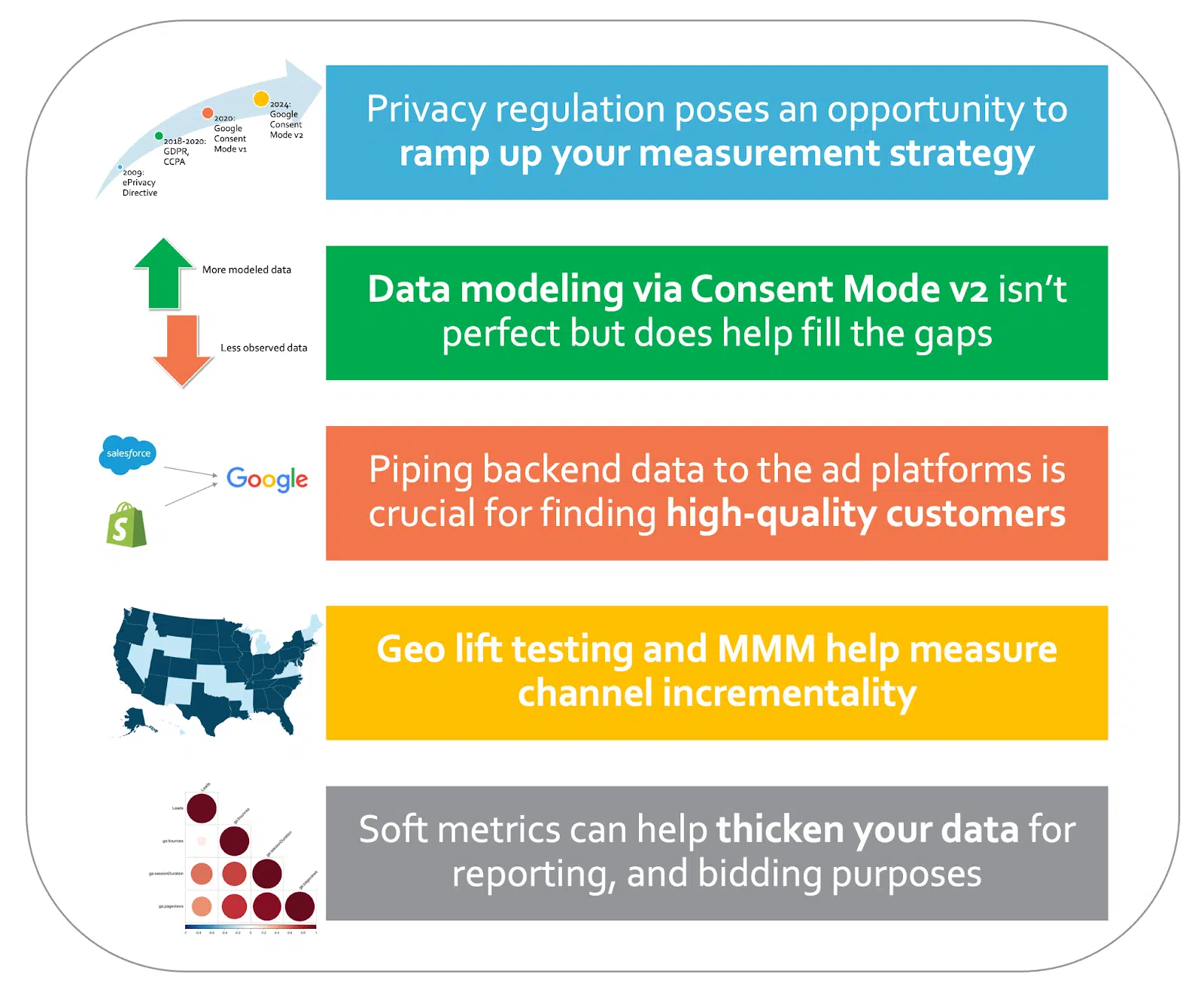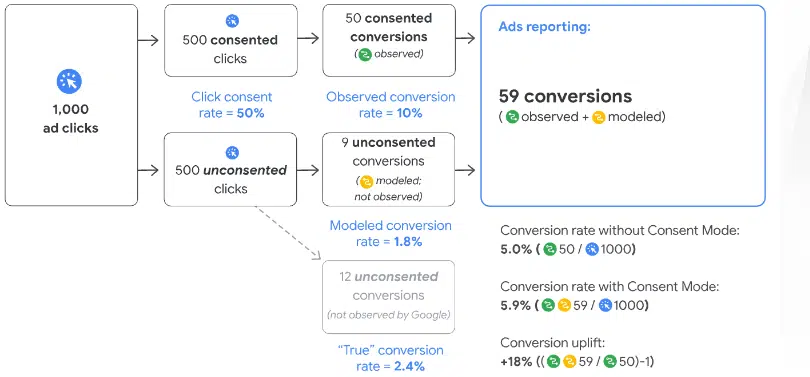I had the opportunity to present at SMX Advanced 2024 on a topic that I live and breathe every week with my agency’s clients: advanced PPC analytics and measurement.
I’ve been working in digital marketing for over 20 years, and in my (rather biased) opinion, intelligent analytics has never been more of a differentiator in marketing campaigns.
Privacy-focused regulations have made measurement more complicated, and AI has deprived marketers of many ways to improve their performance within channels. The proliferation of channel options means it’s imperative to see the big picture.
That said, if you didn’t have a chance to attend the presentation and/or don’t have time to watch the recording, I’ll break down five main takeaways:
- Consent mode v2 gives users even more control.
- The transition from observed data to modeled data is within reach.
- Back-end data implementation is crucial.
- It’s time to embrace cookieless measurement options.
- Proxy measures can fill in the gaps when data is scarce.

1. The importance of Google consent mode v2
In 2012, the ePrivacy Directive (a European Union law on cookies) required websites to obtain consent from visitors before storing/accessing information on their devices. It was the precursor to the 2018 GDPR and, to a lesser extent, the CCPA privacy regulations.
In 2020, Google introduced Consent Mode v1, which allowed website owners to adjust the behavior of Google tags based on users’ consent status and, therefore, comply with GDPR and CCPA.
What new features does Consent mode v2 bring? Essentially, this update requires end users to know how to revoke their consent to ad personalization and allows for anonymous tracking.
Users have more control over their personal data, including the ability to change their preferences. Google obtains anonymous information about visitors without using cookies or other tracking information, but instead using so-called “cookieless pings” for more accurate data modeling.
2. The transition from observed data to modeled data
In short, for advertisers:
You won’t be able to track what individual users are doing, so you’d better prepare to zoom out and work more effectively with a holistic perspective through conversion modeling.
Part of this initiative is implementing consent mode v2, because without this mode you will get less accurate reporting due to limited conversion tracking. You’ll also have fewer and finer audience insights, which can impact audience segmentation and targeting.
Conversion modeling, based on these “cookie-free pings,” requires a daily ad click threshold of 700 ad clicks over a seven-day period per country and domain group.
Its function is to examine how many unwanted clicks lead to conversions. It’s not perfect, but it helps fill the gap in data on a campaign’s overall conversions, even if opt-out users aren’t tracked individually.
In the example below, the advertiser has an opt-in rate of 50% but a decrease in conversions of only 19% (12 out of 62) and an increase in conversion rate of 18% thanks to conversion modeling.

The bottom line is that if you implement both consent mode v2 and conversion modeling (the mechanics of these are too long to go into here), you will remain compliant and mitigate much of the data loss that results.
Dig Deeper: 4 Ways to Check Your Website’s Google Consent Mode Setting
Get the research newsletter marketers rely on.
3. The steps from backend data to foreground
Once user data enters your CRM, it’s first-party data that you own and control – and, as you’ve probably heard ad nauseam over the last 18 months or so, its value in today’s focused landscape on confidentiality reaches new heights.
For what? You can use it for lookalike targeting, remarketing, feeding it back into the bidding and targeting algorithms of major ad platforms to train them to find your best users, and more.
Regardless of your industry, your CRM should be configured to capture data that allows you to segment your users into buckets with different values.
For e-commerce, this can be according to LTV; for B2B and lead generation, this can be done by qualification stages: MQL, SQL, Opps, Closed-won.
Segmenting this data allows you to introduce specific segments into algorithms, which is handy when you don’t have a ton of data density.
For example, if you don’t have enough Opps over a specific period of time to effectively train the algorithms, combine SQL and Opps to achieve the volume you need while maintaining high user quality.
4. Get to know cookie-free measurement methods
Yes, Google has abandoned its plan to remove third-party cookies in Chrome.
But cookie tracking is inherently flawed (user opt-out, no cross-browser tracking, etc.).
Two cookie-free measurement options that I frequently use to analyze client campaigns are:
- Geo-lift tests.
- Media mix modeling.
Geo-lift tests have one big drawback (they only work for one channel at a time), but have many advantages:
- It doesn’t rely on cookies or even ad clicks (because impressions are also valuable).
- It is available on most platforms (GA4, Shopify, Salesforce, etc.).
- You can use it to run experiments in specific geographies (DMAs, states, countries).
- Google’s Causal Impact R package can be used to detect any effects in the test group over time.
- It allows you to measure additional revenue (sessions, new users, purchases, leads) from your marketing budget.
Media mix modeling (MMM), on the other hand, measures historical and holistic channel contributions to help advertisers adjust their budget allocation across channels to achieve better overall performance.
Like geo-lift testing, it has a good list of benefits:
- It does not rely on cookies or even advertising clicks.
- This only requires aggregated channel spend and revenue from your back-end data sources (GA4, Shopify, Salesforce, etc.).
- It allows advertisers to estimate the contribution of each channel.
- Advertisers can use Meta’s Robyn to account for seasonality and latency.
However, MMM is a bit more complicated than geo-lift testing and has the following disadvantages:
- This requires 2 years of data.
- This requires some adjustments.
- Its implementation relies on knowledge of R or Python.
Even with cookies still present, these two measurement methods have consistently produced solid performance and efficiency gains for our customers.
Dig Deeper: How to evolve your PPC measurement strategy for a privacy-first future
5. When data is scarce, use proxy metrics
Because we’re adjusting how we look at data, I’d like to discuss proxy measures. These are “soft” measures that indicate strong engagement and/or are good predictors of meaningful actions.
Because they occur earlier in the customer journey, there are more of them. Although they are less valuable than downstream engagements, understanding this proportion can help you use proxy metrics with decent accuracy.
For example, let’s say you don’t have enough completed forms to feed Google’s auction algorithm. You can do an analysis to understand that approximately one in four users who visit the page with this form end up converting into a lead.
If you know the average value of these leads, you can use the ratio of page views to form completions to calculate the average value of a page view. Then you:
- Create a proxy metric in GTM.
- Integrate the proxy metric into Google Ads, hardcode the nominal value, and collect data for 2-4 weeks.
- Make the proxy metric a main event so that it is used for bid optimization.
- Measure the impact.
Mastering the use of proxy metrics is a great way to keep your campaign analysis agile despite inconsistent data density.
Dig Deeper: 5 Outdated Marketing KPIs to Throw Away and What to Reference Instead
Advanced Analytics Strategies for Modern PPC Campaigns
Here’s a big silver lining: Most of what we just talked about will be relevant no matter what happens with cookies.
My strong recommendation is to roll up your sleeves and familiarize yourself with all of these initiatives now, as each of them has already delivered significant competitive advantages to our customers.
WATCH: Advanced Analytics Techniques for Measuring PPC Performance
Here is my full presentation of SMX Advanced:
Contributing authors are invited to create content for Search Engine Land and are chosen for their expertise and contribution to the search community. Our contributors work under editorial supervision and the quality and relevance of the contributions for our readers are checked. The opinions they express are their own.

